Key takeaways
- EQ is essential in radio broadcasting, enhancing sound clarity and creating a more engaging listening experience by adjusting bass, midrange, and treble frequencies.
- Good audio quality relies on managing frequency ranges and maintaining consistency throughout the broadcast to keep listeners engaged.
- Common audio issues include muddiness and harshness, which can be resolved with careful EQ adjustments, improving the overall sound quality.
- Evaluating results after EQ adjustments is crucial; listening across different playback systems ensures improvements translate well to the audience’s experience.
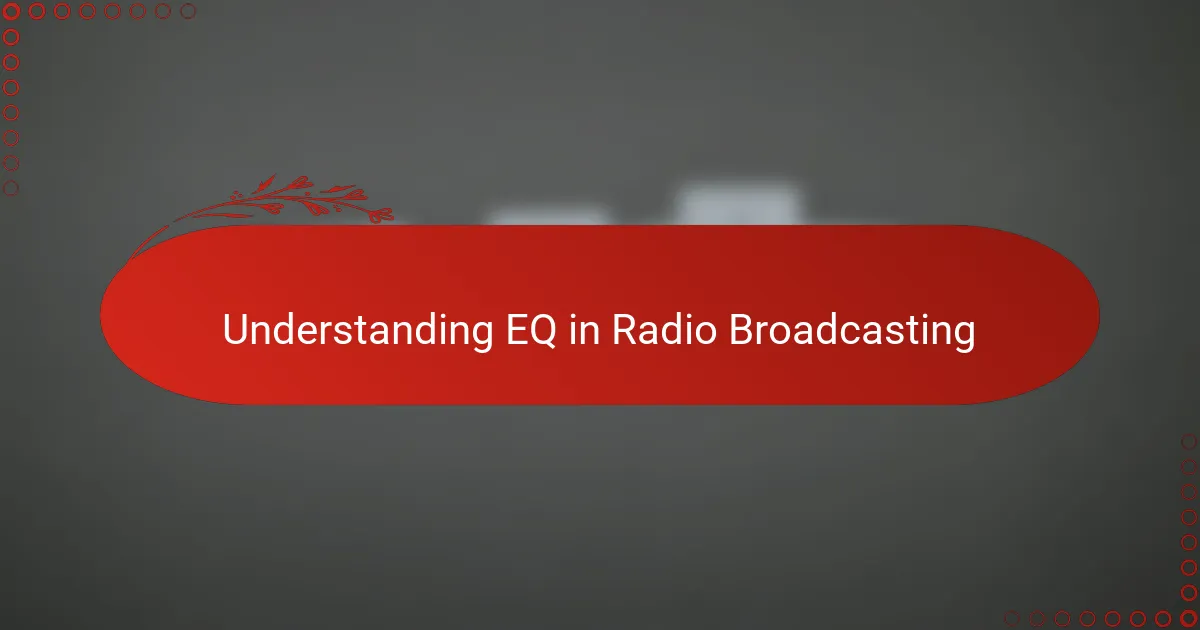
Understanding EQ in Radio Broadcasting
EQ, or equalization, is like the secret sauce in radio broadcasting that shapes how we hear a voice or a sound. From my early days behind the mic, I quickly realized EQ isn’t just about turning knobs randomly—it’s about understanding which frequencies to boost or cut to make a broadcast sound clear and engaging. Have you ever wondered why some voices feel warm and intimate on the radio while others come off harsh or muffled? That’s EQ at work.
In simple terms, EQ lets us adjust bass, midrange, and treble tones to enhance clarity and reduce muddiness. I remember once struggling with a guest whose voice sounded tinny; a subtle cut around the upper mid frequencies transformed the whole segment. It’s fascinating how small tweaks can make the listener feel as if the speaker is right there in the room.
Ultimately, EQ is both art and science in radio. It requires listening closely—not just to the voice, but to how frequencies interact with each other—and then making purposeful adjustments. Have you tried playing with EQ settings yourself? It’s a game-changer that turns ordinary sound into something memorable.
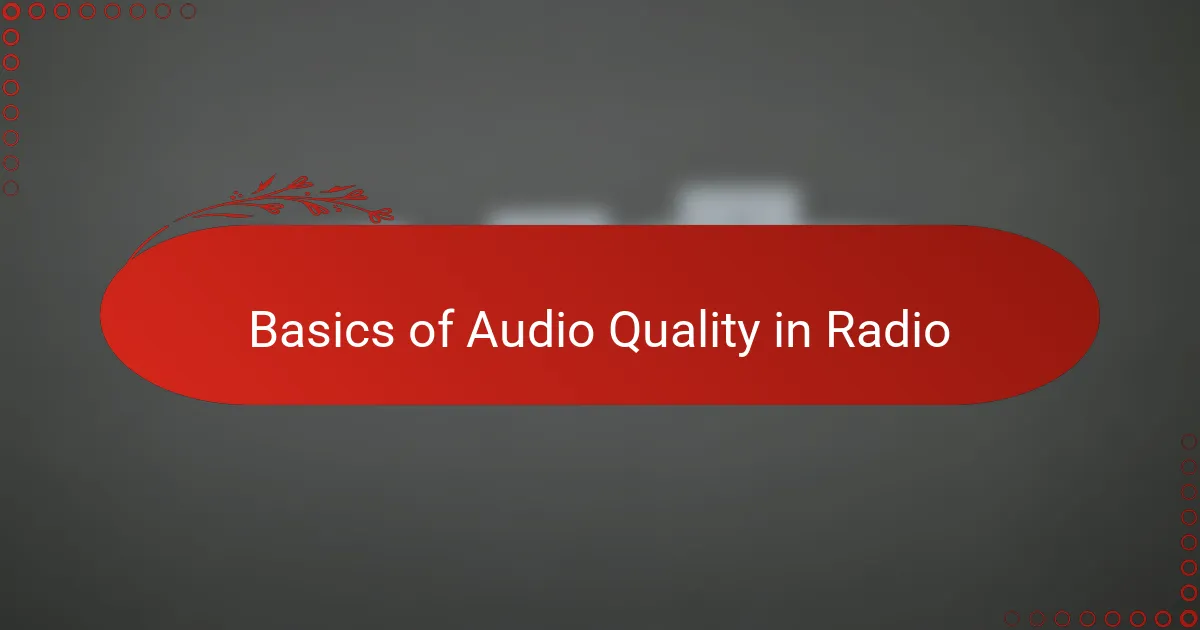
Basics of Audio Quality in Radio
Audio quality in radio isn’t just about having a good microphone or a quiet room; it’s the foundation that shapes how your audience connects with your voice. From my experience, the clarity and balance of sound make all the difference—when audio is crisp, listeners stay engaged, but any muddiness or harshness can make even the best content fall flat. Have you ever found yourself tuning out a broadcast because something sounded off? That’s audio quality at work.
One thing I learned early on is that good audio quality means managing the range of frequencies broadcasted. Radio audio isn’t full-spectrum like live sound—you have to make sure that the essential parts, especially the midrange where human speech lives, cut through clearly. I recall a time when I adjusted frequencies just enough to brighten a dull voice, and suddenly the whole show felt alive and inviting.
It’s also about consistency. Listeners expect a smooth, natural sound throughout a program, and uneven levels or inconsistent tones can be distracting. I’ve often had to listen back and tweak subtle elements to maintain that balance—because in radio, good audio quality isn’t just technical, it’s a promise to your audience that their experience matters.
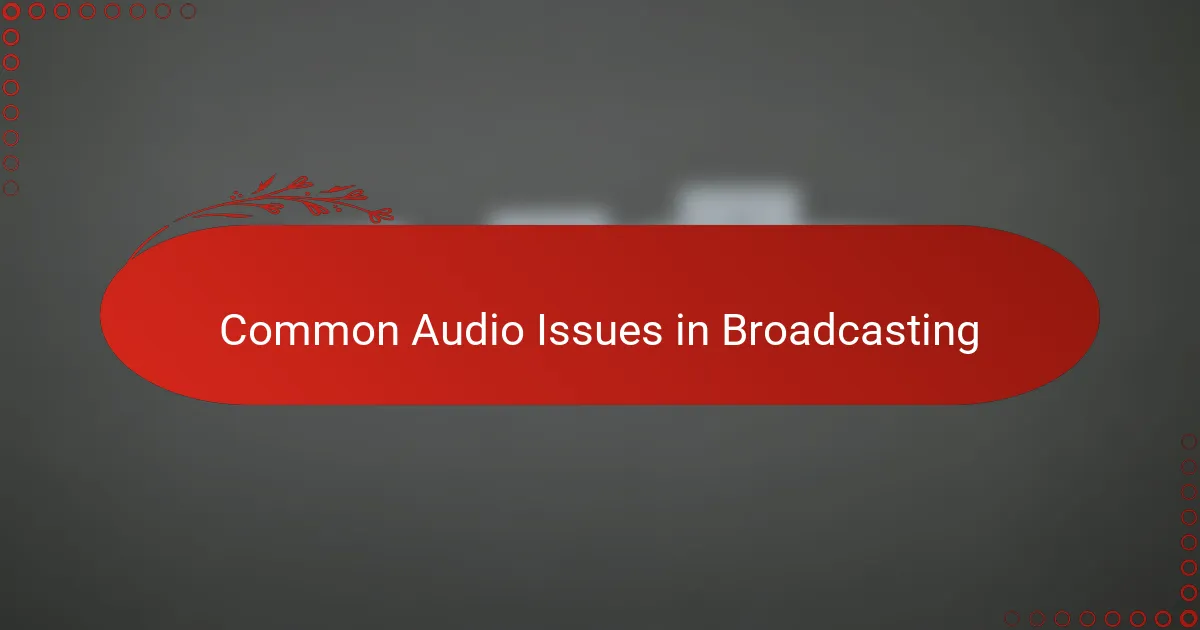
Common Audio Issues in Broadcasting
One of the most common audio issues I’ve encountered in broadcasting is muddiness—where voices sound thick and unclear. I used to struggle with this a lot, especially when multiple people spoke at once or the room acoustics weren’t ideal. Have you ever caught yourself straining to understand what’s being said? That frustration is exactly why addressing muddiness is so important.
Another problem that often pops up is harshness in the higher frequencies, making voices sound sharp or grating after a while. I remember sitting through a live segment where the host’s voice was unintentionally piercing; a quick EQ adjustment to tame those shrill frequencies instantly made the listening experience much more pleasant. It’s amazing how small fixes can change the whole vibe.
Unexpected background noise and inconsistent volume levels also plague many broadcasts. From my perspective, these distractions pull listeners away from the content, breaking their focus. Have you noticed how a sudden spike or dip in sound can jolt you? That’s why controlling these issues is crucial to keep your audience glued to the mic.
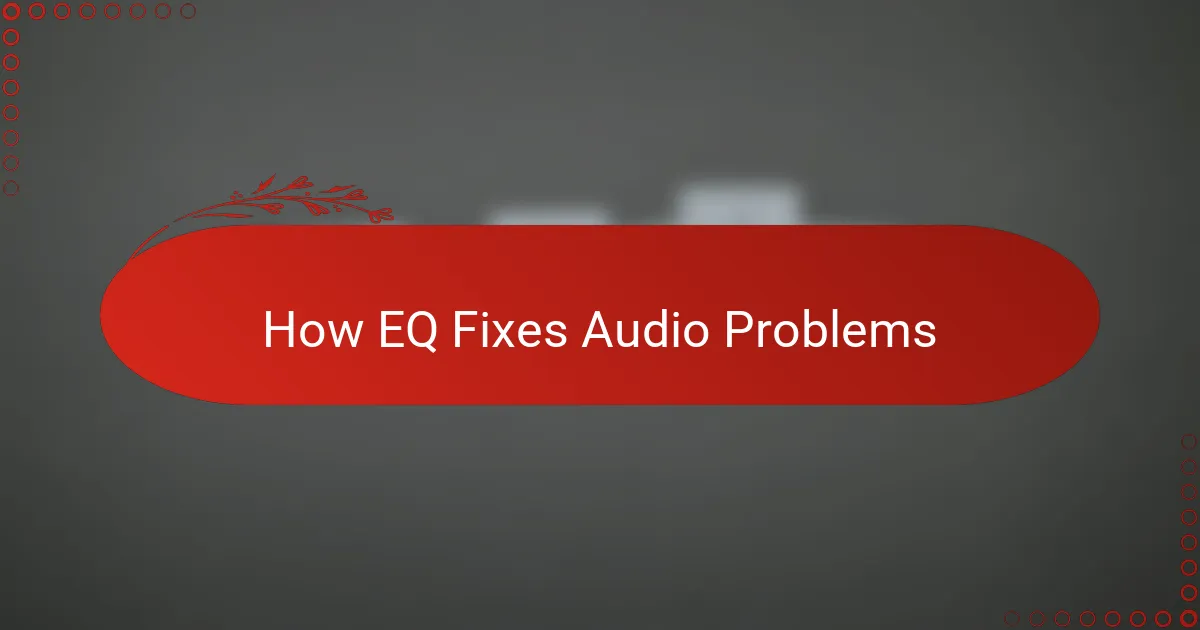
How EQ Fixes Audio Problems
When I first started using EQ to fix audio problems, I was amazed at how pinpointing specific frequency ranges could solve issues like muddiness or harshness almost magically. Have you ever wondered why cutting just a few decibels around certain mid or high frequencies can suddenly make a voice cleaner and easier to understand? That precise control is what makes EQ such a powerful tool in broadcasting.
I recall one late-night show where the guest’s voice was so boomy it filled the entire frequency spectrum, making it hard for listeners to focus. By carefully reducing the low-end frequencies with a low-cut filter, I cleared up the sound instantly, creating more space for clarity and presence. It felt like turning down a veil that had been muffling the conversation—listeners could finally connect with the speaker naturally.
Sometimes, EQ acts like a gentle sculptor shaping the audio rather than a drastic fix. For example, when I noticed a harsh edge in a host’s voice, a small dip in the upper midrange softened the tone without losing energy. Have you tried those subtle cuts yourself? They don’t scream “I’m an EQ adjustment,” but they do make the difference between a tiring broadcast and one that keeps listeners comfortable and engaged.

Step by Step EQ Setup Process
Getting started with EQ means first identifying the problem frequencies. I usually begin by listening closely to the raw audio and then sweeping through the frequency bands one at a time, boosting slightly to spot any harsh or muddy tones. Have you ever noticed how a small peak or dip in a certain range can suddenly jump out? That’s your cue to make precise adjustments.
Next, I like to apply gentle boosts or cuts rather than drastic changes—EQ isn’t about fixing everything at once but about subtle sculpting. For instance, reducing some low mids can clear up muddiness, while a slight lift in the high mids can add presence without sounding piercing. In my experience, patience here pays off; rushing the process usually leads to unnatural or fatiguing sound.
Finally, I always circle back to listening in context, especially through the actual radio transmission path. Does the voice sound balanced and natural, or does it still feel off? I remember countless times where a setting that seemed perfect in the studio needed fine-tuning once on-air. That step of critical listening and tweaking is what really elevates audio from good to great.
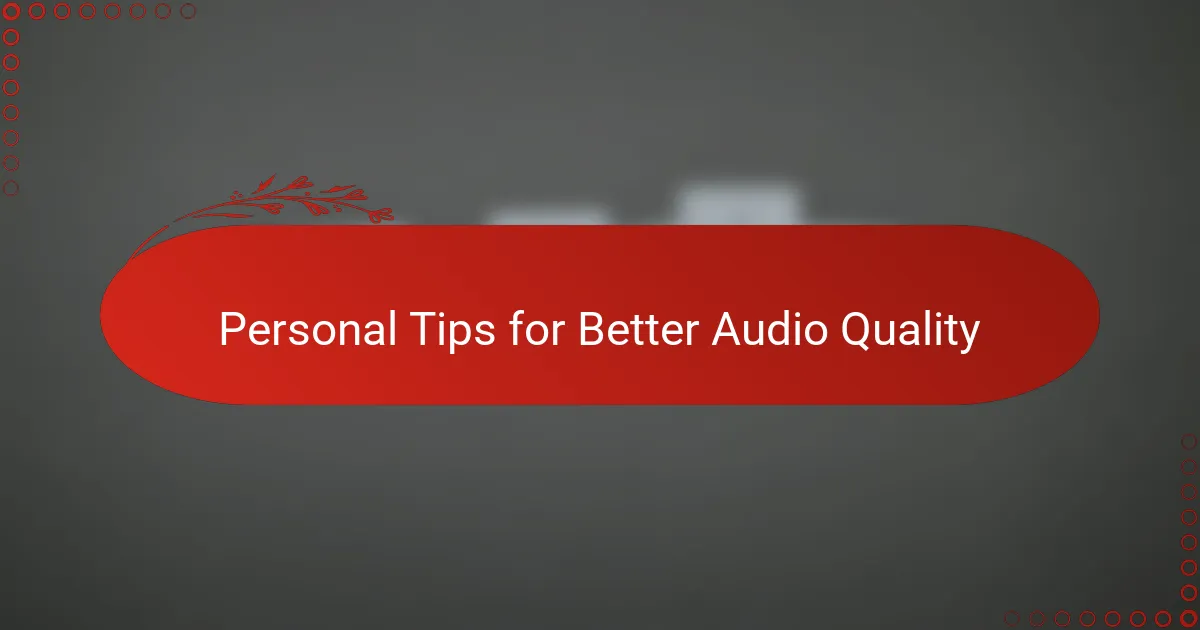
Personal Tips for Better Audio Quality
One tip that’s helped me tremendously is trusting my ears above all else. You can have all the fancy meters and software, but if a voice still sounds harsh or dull to you, it probably will to listeners as well. I often take short breaks during mixing because a fresh ear catches issues that fatigue can easily mask. Do you find your ears getting tired after long listening sessions? That’s exactly why patience and frequent pauses are so valuable.
Another strategy I swear by is the “less is more” approach with EQ adjustments. Early on, I made the mistake of cranking up every frequency that seemed off, only to end up with a cluttered, unnatural sound. Now, I start with tiny boosts or cuts—sometimes just 1 or 2 decibels—and listen closely before making more changes. Those minimal tweaks often create the biggest improvements without stealing the voice’s natural character.
Finally, I always consider the environment in which the audio will be heard. Radio listeners often tune in through car speakers, earbuds, or even low-end radios, so I try to simulate those conditions before finalizing settings. It’s amazing how a well-balanced EQ on studio monitors can sound completely different on a cheap speaker. Have you experimented with listening on various devices? Doing so helped me better understand what adjustments truly matter to the audience.
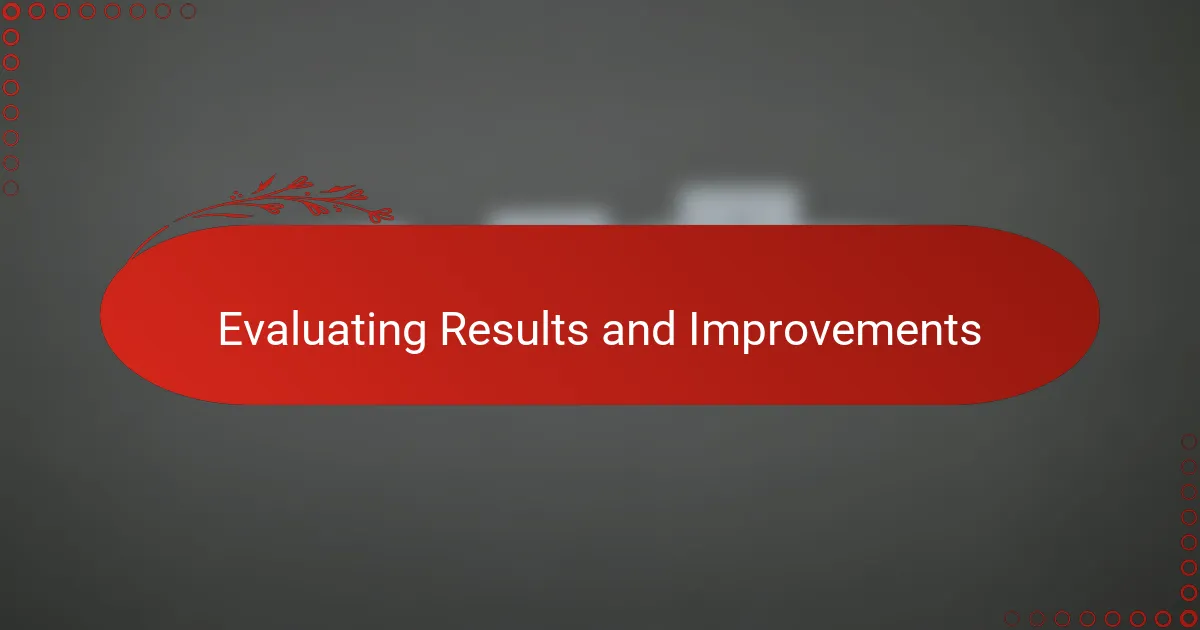
Evaluating Results and Improvements
Evaluating the results after applying EQ is where the real satisfaction kicks in. I usually listen back through different playback systems—studio monitors, headphones, and even a phone speaker—to make sure the improvements hold up everywhere. Have you ever noticed how a mix that sounds great in the studio suddenly feels off on your phone? That’s why this multi-listening step is crucial.
Sometimes, the changes feel subtle at first, but over time, you realize how much clearer and more natural the voice sounds. I recall a particular broadcast where a slight midrange cut made all the difference; listeners actually complimented the host’s tone afterward. It’s those moments that remind me EQ isn’t just technical tinkering—it’s shaping a better connection with the audience.
Of course, not every adjustment sticks on the first try. I find it essential to compare before-and-after clips and even gather feedback from colleagues or trusted listeners. Have you ever gotten caught in a cycle of second-guessing your EQ choices? I have, but stepping back and reviewing with fresh ears always helps confirm what really works.
